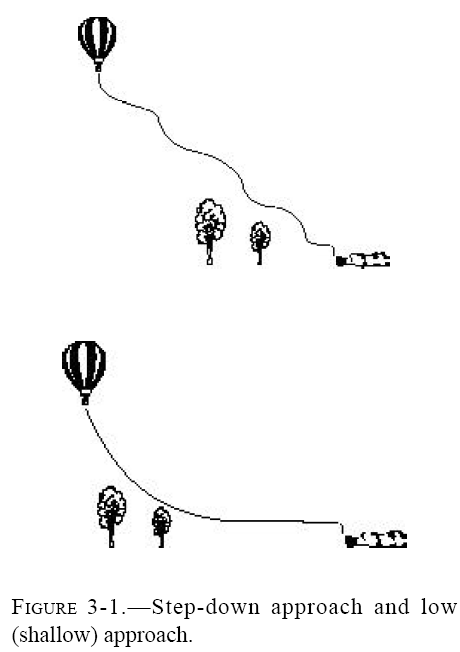APPROACH TO LANDING
No other aircraft has as many different types of
landings as a balloon. Most aircraft, including gliders
and helicopters, land on relatively smooth, hard
places. Balloons rarely land on smooth, hard places.
Since the balloon is stronger than people are and less
susceptible to damage, a soft landing is one that is
judged to be easy on the passengers.
Birds are probably the only flying things that have
more available landing sites. Balloons can land safely
in places that most other aircraft cannot. Balloons
can land on the ground or in the water, on the flat or
side of a hill, in bushes or trees (with maybe a little
damage), on plowed and irrigated fields, in snow or
mud. There is an infinite variety of suitable balloon
landing sites and rarely are two balloon landings alike.
When a landing site is being considered, you should
first think about the suitability of the site. “Is it safe,
is it legal, and is it polite?” When considering surface
winds, you should make certain there is adequate
access to the site with respect to obstructions.
Some Basic Rules of Landing
The final, safe resting place of the balloon is a major
consideration in landing. Making a soft landing is not
as important as getting the balloon where you want it.
Having an easy retrieval is not as important as an
accident-free, appropriate landing site.
Plan the landing early enough so that fuel quantity
is not a distraction. Plan on landing with enough
fuel so that even if your first approach to a landing
site is unsuccessful, there is enough fuel to make a
couple more approaches.
The best landing site is one that is bigger than you
need and has alternatives. If you have three
prospective sites in front of you, aim for the one in
the middle in case your surface wind estimate was
off. If you have multiple prospective landing sites
in a row along your path, take the first one and
save the others for a miscalculation. Unless there
is a 180° turn available, all the landing sites behind
are lost.
The best altitude for landing is the lowest altitude.
Anyone can land from 1 foot above the ground; it
takes skill to land from 100 feet.
A low approach, assuming no obstacles, gives you
the slowest touchdown speed because the winds
are usually lightest close to the ground.
It is usually better to fly over an obstacle and land
beyond it than to land in front of it. Overfly
powerlines, trees, and water, among other
obstacles, on the way to the landing, rather than
attempting to land in front of them and risk being
dragged into them.
Before beginning your approach, plan to fly a
reasonable descent path to the landing site, using
the step-down approach method, the low (shallow)
approach method, or a combination of the two.
[Figure 3-1]

|

